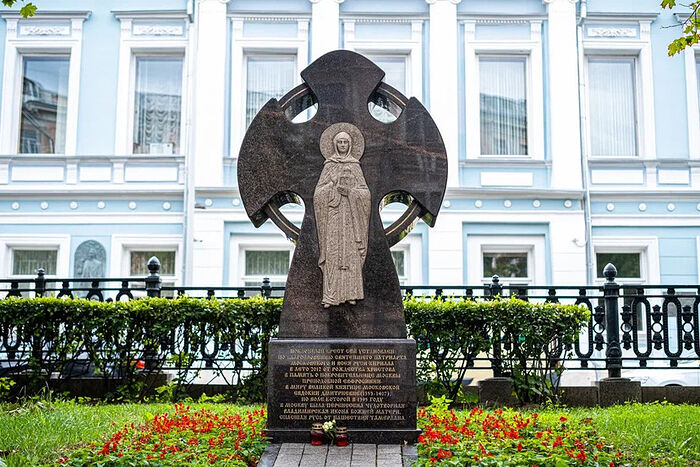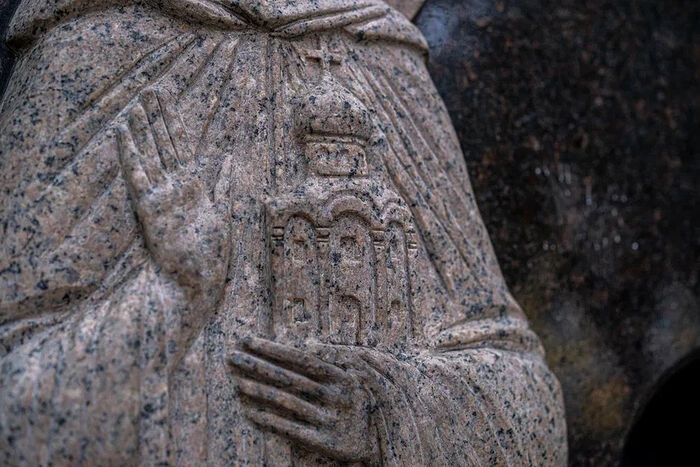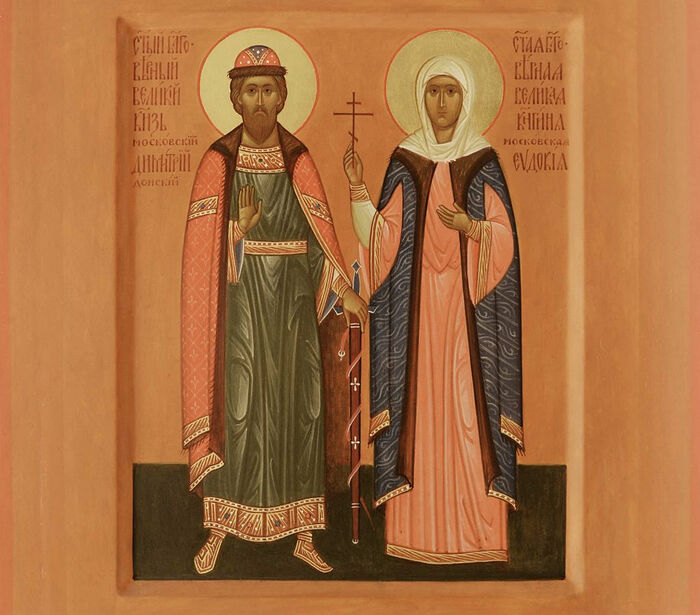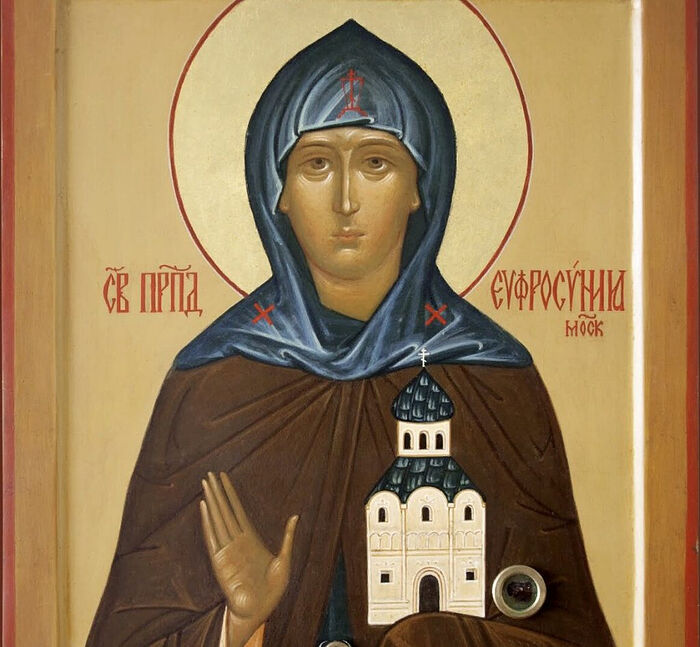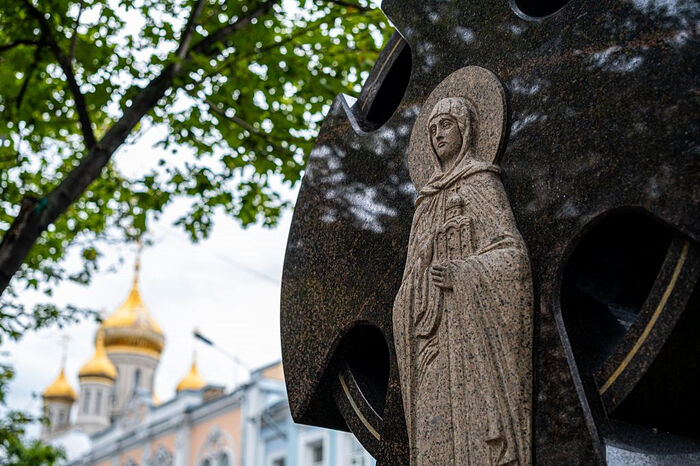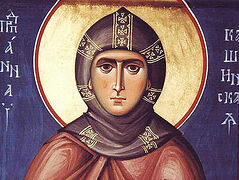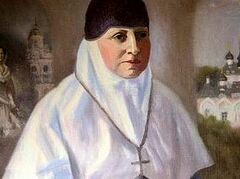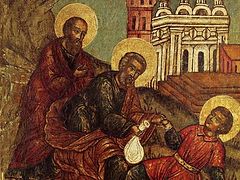There is a parallel line to Rozhdestvensky Boulevard stretching from Trubnaya Square to the Sretensky Gate. Just about 600 yards along the wall (which has been invisible for a long time) of the “White City”,1 where history preserves important dates, and memory honors holy names. The Boulevard begins with the Convent of the Nativity of the Mother of God and ends with Sretensky Monastery. Between the two monasteries associated with the name of the holy Right-Believing Grand Princess Eudoxia (also Evdokia) of Moscow, named Euphrosyne in monasticism, stands a memorial cross dedicated to her. People stop at the cross, pray and ask for her protection, advice and help, just as it was in her lifetime. After all, good deeds are not forgotten, the soul lives forever, and prayer works wonders.
In 1353, in Suzdal, in the family of Prince Dmitry Konstantinovich “the Elder” (1322–1383; from the Rurik family) and his wife Anna, a daughter was born who was named Eudoxia [feasts: May 17/30 and July 7/20), which means “goodwill, love”. This name would determine this great Russian woman’s earthly path, spiritual quest and good deeds. In her father’s house, Eudoxia received a good education and was brought up in the spirit of Christian piety. Here she realized that to be a princess means to serve your Fatherland, God, and people. So it would be in her life.
Eudoxia spent her childhood in the beautiful and glorious Russian towns of Suzdal and Pereslavl-Zalessky, crowned with monasteries and churches. She would read a lot. These were works by Aristotle, Plato, Homer, Virgil, Hippocrates and Galen. And she prayed much. Her soul was moved by the image of the Orthodox Saint Euphrosyne of Suzdal, born Princess Theodulia Mikhailovna of Chernigov (1212–1250), a daughter of Prince Mikhail Vsevolodovich. Theodulia was the first child in the prince’s family, obtained by earnest prayers. Smart and inquisitive, she grew up to the delight of her parents. One day Fyodor Yaroslavich, Prince Alexander Nevsky’s brother, became her fiancé. But the young man died suddenly. Then Theodulia was tonsured with the name Euphrosyne at the Suzdal Convent in dedicated to the Placing of the Honorable Robe of the Mother of God in Blachernae (1207). Through her efforts, the Holy Trinity Convent intended for widows with the Holy Trinity Cathedral and the Holy Gate was founded next to the Convent of the Placing of the Honorable Robe of the Mother of God. St. Euphrosyne wanted to separate the life of the nuns who were virgins from that of the widows. Princess Eudoxia kept this saint’s name in her heart all her life, and in many ways became like her.
Eudoxia’s father, Prince Dmitry Konstantinovich, went down in the history of Rus’ as the Prince of Suzdal, the Grand Prince of Suzdal-Nizhny Novgorod and the Grand Prince of Vladimir. He became famous for the fact that in 1372 he set up the first stone Kremlin in Nizhny Novgorod. At his orders, in 1377, the Laurentian Chronicle was written, which till the early eighteenth century was kept at the Monastery of the Nativity of the Theotokos in the city of Vladimir. The prince’s involvement in internecine wars and relations with representatives of the Golden Horde are known as well. So, in order to stop the strife between the principalities of Moscow and of Suzdal–Nizhny Novgorod, Grand Prince Dmitry Konstantinovich decided to marry his daughter Eudoxia (1353–1407) to Prince Dmitry Ivanovich of Moscow (1350–1389). The young prince Dmitry, who had lost his father, was blessed for marriage by his spiritual mentor and guardian, Metropolitan Alexei of Kiev and All Rus’.
It was he who, after the death of Prince Ivan II Ivanovich the Fair (1326–1359), actually ruled the principality until Dmitry came of age. It was an example of a unique combination of secular and spiritual power, as well as sincere faith in God. In his addresses to the people, the Holy Hierarch Alexei called on all Russians to support each other, and the boyars—tuno mercy and truth. Metropolitan Alexei was indeed a great comforter of the Russian people. Having such a person as a guardian and teacher bore fruit: Prince Dmitry was faithful to the Russian land, people and God, accomplishing many military feats for them, becoming the glorious Prince Dmitry Donskoy.
Such a husband was prepared by God for Princess Eudoxia. Dmitry and Eudoxia were married on January 18, 1366 at the Church in honor of the Renewal of the Temple of the Resurrection of Christ in Jerusalem of the Kolomna Kremlin, because Moscow had once again been burned down by the enemy. For over 500 years, right up to the Revolution of the turbulent twentieth century, the ladle for the wine used during the wedding of Prince Dmitry and Princess Eudoxia, was lovingly kept here.
At the time of their wedding, Dmitry was sixteen, and Eudoxia was thirteen. We do not know anything for certain about their first meeting and how they became attached to each other. Tradition has it that Eudoxia first saw her future husband from the window of her terem,2 when Dmitry came to Eudoxia’s father to discuss the question of who would reign in Vladimir. Perhaps this is the truth. Another version is that Eudoxia prayed in front of the Vladimir Icon of the Mother of God and asked Her to make Prince Dmitry her husband. But what really matters is that their dynastic marriage was a happy one, and the spouses preserved love and respect for each other throughout their lives. The Orthodox faith cemented their union.
A blessed Family: One Soul in Two Bodies
After the wedding, the newlyweds took up their residence in Moscow. In this city, Eudoxia’s spirituality, kindness, compassion and desire to help people were manifested to the upmost. The city was suffering from fires, diseases, and pillage. Hundreds of unfortunate people would come to the princess for help and no one was ever turned away. Help came from the princess’ personal funds. No one saw her depressed. She helped tirelessly, giving everyone her quiet smile, amazing everyone with her cheerfulness and firm faith in God. At that time, Eudoxia’s father-confessor was Abbot Theodore (c. 1340–1394) of Simonov Monastery, a disciple and nephew of St. Sergius of Radonezh.
The marriage of Prince Dmitry and Princess Eudoxia lasted twenty-three years, full of love and harmony, and was crowned by twelve children. The Venerable Sergius of Radonezh became the godfather of two of them.
The reign of Dmitry would coincide with one of the most difficult yet glorious periods of history, when the Russian lands began to unite around Moscow and significant victories were won over the Golden Horde. His wife was always with the prince, in joy and in sorrow. When Prince Dmitry went on military campaigns, the principality and family remained entrusted to the care of Princess Eudoxia. For his wisdom and strong character shown in public affairs, contemporaries called the prince “the high-soaring eagle.” They also highly esteemed the prince’s wise and virtuous wife Eudoxia. The couple was surrounded by figures great in their wisdom and nobility: Sts. Sergius of Radonezh (1314–1392), Savva of Storozhev (?–1407) and Cyril of the White Lake Monastery (1337–1427).
Before the Battle of Kulikovo, Prince Dmitry received the blessing of the “Abbot of the Russian land”—St. Sergius of Radonezh, which breathed into him the spirit of victory. The blessing was followed by a prophecy of his victory. His wife’s love preserved the prince as well. During the battle, he miraculously survived thanks to a vision of his beloved Eudoxia. After the Battle of Kulikovo, not only did she treat her husband, who has been known as Dmitry Donskoy3 ever since, but she also organized a hospital in Moscow for wounded soldiers.
The Venerable Cyril of the White Lake Monastery also played a significant role in the life of the family. He wrote a letter to the adult sons of Prince Dmitry Donskoy. In it he asked Vasily to reconcile with the princes of Suzdal, Andrei to be fair, and Yuri to battle with his sins. The Venerable Savva of Storozhev, who on the account of his miracles is called by many a patron of Moscow and a protector of kings, became Princess Eudoxia’s spiritual father after her husband’s death and blessed Yuri Dmitrievich for his military campaign to the middle Volga, which ended in his victory.
Their children were their mutual joy. Together the spouses settled the lives of their children, while consolidating the Russian lands and putting an end to the enmity between the princes. Their daughter Sophia was married to Prince Oleg of Ryazan. The marriage of their son Vasily made Rus’ and Lithuania related, and the marriage of their son Yuri reconciled it with Smolensk. Their daughters-in-law and sons-in-law respected the wise Princess Eudoxia, a calm and loving mother. They owed their faith in God to her. Prince Yuri and his wife Anastasia took care of the churches, and Anastasia embroidered vestments for her father-confessor, St. Savva of Storozhev.
Together, Prince Dmitry and Princess Eudoxia built the city. Under the Grand Prince the white-stone Kremlin, the Andronikov (1357) and Simonov (the 1370s) Monastery-fortresses were constructed in Moscow, protecting the approaches to it. To immortalize the victory at the Battle of Kulikovo in 1380, Princess Eudoxia set up the Church of the Nativity of the Most Holy Theotokos on Seny (1393–1394) at the Moscow Kremlin. The church was decorated with frescoes and icons by Theophanes the Greek (1340–1410) and Simeon Cherny (?–1395) with their students. This work was commended in the Book of Degrees of the Royal Genealogy. The princess participated in the construction of the Convent of the Nativity of the Most Holy Theotokos (1386), helping Princess Maria Ivanovna of Serpukhov (in schema Martha), the mother of Vladimir Andreevich the Bold, a cousin of Dmitry Donskoy, who heroically fought in the Battle of Kulikovo,. Whatever the princess did was always pleasing to God.
The protectress of Moscow. 1395
Princess Eudoxia truly shared in her husband’s exploit in serving the Fatherland, in liberating the Russian land from the Mongol-Tatar yoke.
In 1395, the troops of Khan Tamerlane (1336–1405) approached the borders of Rus’. The army of Grand Prince Vasily I Dmitrievich (1371–1425), a son of Dmitry Donskoy and Princess Eudoxia, came out to meet him. Not only did the princess pray tirelessly to God, asking Him to save the Russian land, but she also advised Prince Vasily to bring the wonderworking Vladimir Icon of the Mother of God to Moscow to protect the city. On August 26, Princess Eudoxia, her sons, the Metropolitan, the clergy, and the boyars came out to meet the icon at Kuchkovo Field. At that time, Tamerlane had a vision of a “shining Lady”, surrounded by radiance, and “lightning-like warriors”, menacingly and boldly moving towards him. The khan, who had already reached Yelets, gathered a council at which he decided to retreat and not to invade Moscow. At the meeting place of the icon the Moscow Sretensky Monastery was founded in 1397.
Nun Euphrosyne
In 1389 ended the earthly path of Prince Dmitry Donskoy, who knew Russia and the art of ruling (as the historian N. M. Karamzin said about him). After his death the light faded for Princess Eudoxia. “Who am I now?”—as if conveying her thoughts, The Tale of the Life of Grand Prince Dmitry Ivanovich reads. But the Grand Princess remained a loving mother and a wise ruler. After all, passing the throne to his eldest son Vasily, Grand Prince Dmitry’s will was that his mother should be his co-ruler. But, participating in the affairs of the principality and the lives of her children, she increasingly thought about the monastic life and wore chains and a hair-shirt beneath her clothes, observing very strict fasts. The princess would go to pray at the Ascension Convent founded by her (1386) at the Kremlin, located at the Florus Gate, where she would see off and meet her beloved husband, Grand Prince Dmitry. Near the gate used to be their terem, burned down by the Crimean Khan Tokhtamysh (1342–1406) in 1383. Monastic cells were built on this site. Eudoxia loved to visit the Holy Conception Convent (1360), built with the blessing of Metropolitan Alexei of Moscow. In her beloved Pereslavl-Zalessky, services were celebrated at the churches built by her. One of them, in honor of the Icon of the Mother of God of the “Sign”, was erected to commemorate the miraculous salvation of the princess during the invasion of Pereslavl by Tokhtamysh in 1382.
In 1407, the princess had a vision of the Archangel Michael, who brought news that she would die soon. The princess decided to receive the monastic tonsure and ordered an icon of the Archangel Michael to be painted, which was placed at the Kremlin Church of the Nativity of the Most Holy Theotokos on Seny. On May 17, at the wooden Church of the Ascension of Christ of the Ascension Convent, Princess Eudoxia took monastic vows. Her new name was Euphrosyne, like that of St. Euphrosyne of Suzdal, whom she venerated. It is translated from Greek as “good”, of which there was so much in the life of Princess Eudoxia. According to legend, many sick people were healed on that significant day. A few days after she had taken her vows, the stone Church of the Ascension of Christ, in which St. Euphrosyne had wished to be buried, was erected. On July 7, the Grand Princess (and now a simple nun) fell asleep in the Lord. Her veneration in Moscow as a saint began immediately after her repose. Her official canonization apparently took place in 1857–1869. St. Euphrosyne became the only woman representative of Muscovy to be ranked among the saints.
The will of the princess was fulfilled, and the relics of the saint of the Russian Orthodox Church rested in the Ascension Church until 1929, continuing to give people her generous and gracious help. In 1929 the church was blown up and the relics were lost. But fortunately they were rediscovered in 2002 along with her leather monastic belt. Now the Venerable Euphrosyne rests next to her husband Grand Prince Dmitry Donskoy at the Chapel of Martyr Warus in the Cathedral of the Archangel Michael of the Moscow Kremlin. For the past eight years, June 1 has been the joint feast of the holy couple.
The memory of St. Euphrosyne of Moscow
And yet the name of this great woman, the patroness of the capital, has been unjustly forgotten. However, at one time every Moscow household had an icon of St. Euphrosyne, which helped heal various infirmities, including eye diseases and blindness.
But the memory of St. Euphrosyne of Moscow was revived and inspired our contemporaries to good deeds. In 2012, her memory was immortalized in a place that is holy for Moscow: where the Muscovites met the Vladimir Icon of the Mother of God in 1395—that is, 617 years later, a memorial cross was erected by the sculptor Albert Serafimovich Charkin (1937–2017). On a canvas of dark stone there is the white figure of a woman in monastic robes: her right hand blesses, while her left hand holds the cathedral. To pray to God and bless, encourage the construction of churches and monasteries, to grieve and rejoice with us, fight and win together with the Russian people. And today, like a pure spring, the spiritual feat of St. Euphrosyne and her care for us are inexhaustible.

